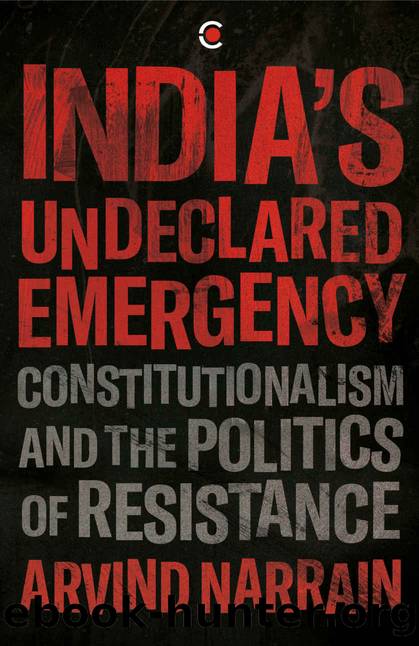India's Undeclared Emergency: Constitutionalism and the Politics of Resistance by Arvind Narrain

Author:Arvind Narrain [Narrain, Arvind]
Language: eng
Format: epub
Published: 2022-01-10T11:00:00+00:00
Easy Complicity Between the Executive and the Judiciary
The closeness between the executive and the judiciary through the chief justiceship of Misra, Gogoi and Bobde during 2017â21 is perhaps best symbolised by Gogoi taking oath as a nominated member of the Rajya Sabha four months after retiring from the Supreme Court. Gogoi said that he accepted the nomination because of his âstrong conviction that the legislative and the judiciary must at some point of time work together for nation-buildingâ. He asserted that his âpresence in Parliament will be an opportunity to project the views of the judiciary before the legislature and vice versaâ.253
The only other precedent for this was the election of former chief justice of India Ranganath Mishra to the Rajya Sabha on a Congress ticket in 1998, seven years after his retirement.254 However, compared to the impropriety of Ranganath Mishra, Gogoiâs acceptance of a nomination to the Rajya Sabha a mere four months after retirement raises more fundamental questions about the independence of his judgements pertaining to âimportant constitutional lodestars: Habeas corpus, non-discriminatory citizenship, the evidence act, federalism, free speechâ, as Pratap Bhanu Mehta points out in an article for the Indian Express. âThe very fact that a judge accepts such an appointmentâ, writes Mehta, âcould cast doubt on his judgements. It would signal that the judiciary is not independent, but lives for crumbs thrown by the executiveâ.255 As Justice Shah told NDTV, â⦠the message it sends to the judiciary as a whole is that if you give judgments that are favourable to the executive, you will be rewarded. If you donât do so, you will be treated adversely or you might be transferred or not considered for elevation.â He called it a âdeath knell for the separation of powers and the independence of the judiciaryâ.256
In his blog, legal scholar Gautam Bhatia argues that Gogoiâs tenure saw the drift of the Supreme Court from âan institution thatâfor all its patchy historyâwas at least formally committed to the protection of individual rights as its primary task, to an institution that speaks the language of the executive, and has become indistinguishable from the executiveâ.257 Bhatia sees this drift to an executive-minded court in Gogoiâs use of âsealed cover jurisprudenceâ while he was the chief justice.258 The executive was asked to submit replies in sealed covers on the basis of which the judiciary would pass orders. The contents of the âsealed coverâ were not known to the other parties to the litigation. This fundamentally impinges on the right to a fair trial. Justice Gogoi used this mode in litigations on Rafale, electoral bonds and Assam NRC, as well as in many other matters, rendering justice opaque.259
Former Supreme Court judge Lokur writes in the Wire how, in 2019, under the chief justiceship of Gogoi, a bench headed by Justice N.V. Ramana denied the petitioners a copy of the final Juvenile Justice Committee report on the detention of children in Kashmir with the report being submitted in a sealed cover to the court.
Download
This site does not store any files on its server. We only index and link to content provided by other sites. Please contact the content providers to delete copyright contents if any and email us, we'll remove relevant links or contents immediately.
Killers of the Flower Moon by David Grann(3761)
Machine Learning at Scale with H2O by Gregory Keys | David Whiting(3675)
Oathbringer (The Stormlight Archive, Book 3) by Brandon Sanderson(2671)
Will by Will Smith(2596)
Once Upon a Broken Heart by Stephanie Garber(2549)
Guns, Germs and Steel by Diamond Jared(2208)
Borders by unknow(2122)
It Starts With Us (It Ends with Us #2) by Colleen Hoover(2061)
The Room Where It Happened by John Bolton;(2039)
Friends, Lovers, and the Big Terrible Thing by Matthew Perry(2019)
The Color of Law by Richard Rothstein(1826)
HBR's 10 Must Reads 2022 by Harvard Business Review(1705)
The Strength In Our Scars by Bianca Sparacino(1702)
A Short History of War by Jeremy Black(1681)
Water Rights and the Environment in the United States by John Burch(1611)
Examples & Explanations: Administrative Law by William F. Funk & Richard H. Seamon(1560)
515945210 by Unknown(1526)
Pharmacy Practice and The Law by Richard Abood(1498)
That Every Man Be Armed by Stephen P. Halbrook(1485)
